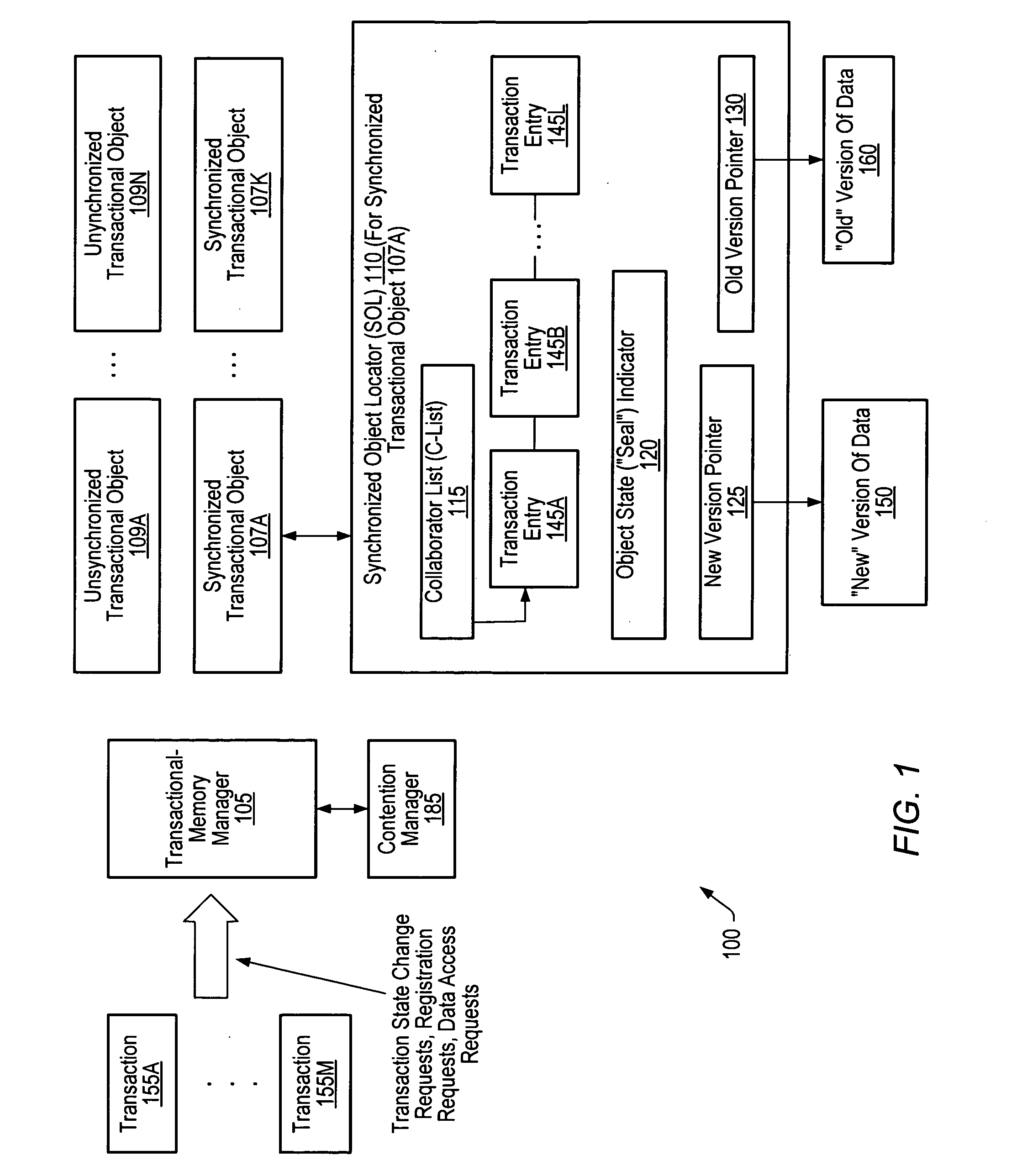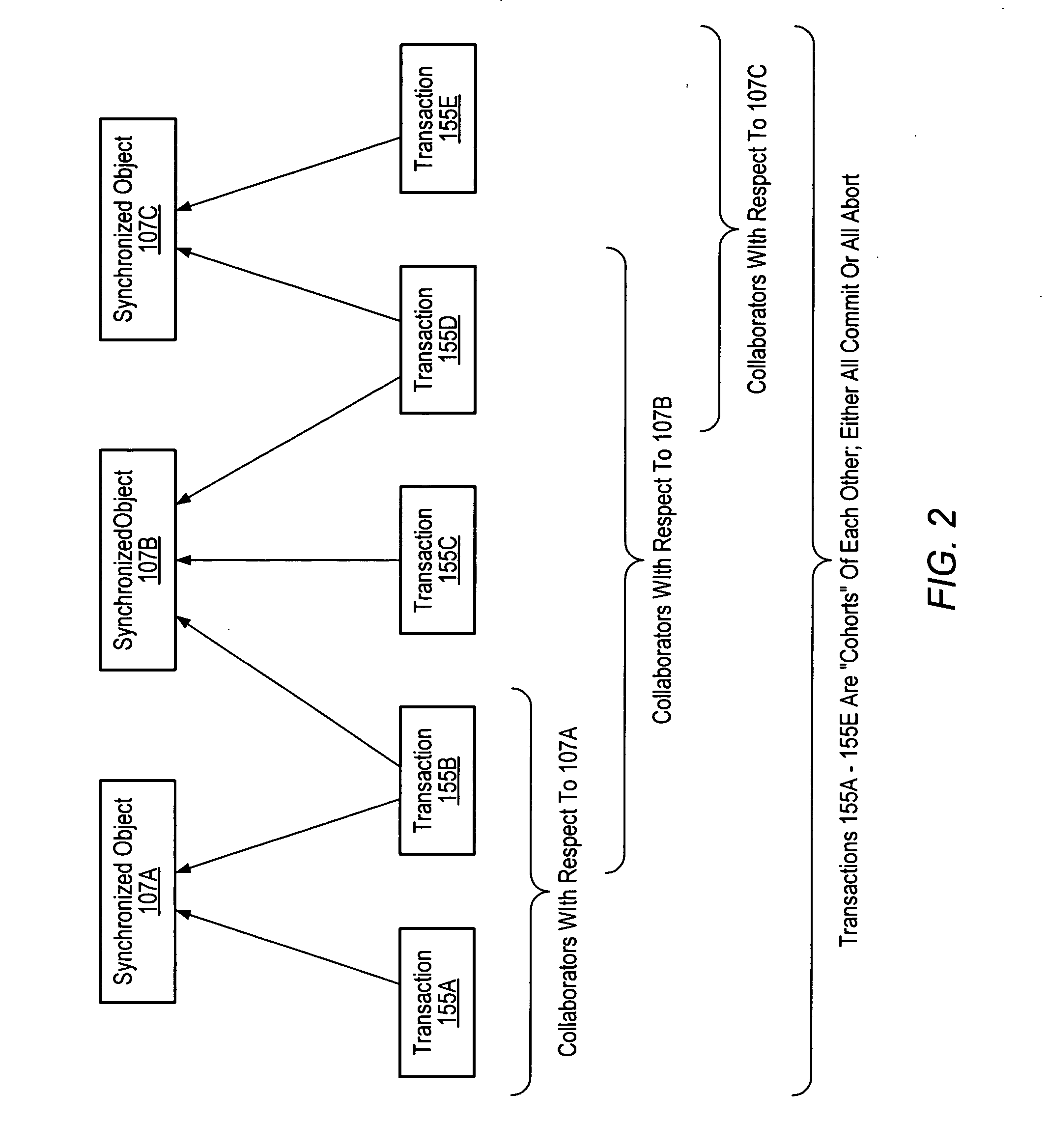[0008] Various embodiments of methods and systems for implementing synchronized objects for software transactional memory are disclosed. According to one embodiment, a system comprises one or more processors and a memory comprising program instructions executable by the processors to implement a transactional-memory manager configured to coordinate memory access requests directed at the memory from a plurality of transactions. The transactions may each comprise a set of operations, e.g., specifying memory locations at an address level, and transaction boundaries may be defined programmatically within application code. The transactional-memory manager may be configured to record, within a collaborator record for a shared data object in the memory, identifications of a set of two or more transactions that have each requested synchronization on the object (e.g., so that each transaction of the set may see uncommitted updates performed on the shared object by other transactions of the set). In response to a commit request from a given transaction of the set, the transactional-memory manager may be configured to determine whether to commit or abort the given transaction based at least in part on the transactional states of other transactions in the set, examining the collaborator record to identify the other transactions. If the transactional-memory manager determines that the given transaction is to be committed based on the states of the other transactions, it may commit the given transaction; otherwise, the given transaction may be aborted, or may have to wait until either the other transactions are all ready to commit or at least one of the other transactions aborts. By requesting synchronization on the shared data objects, the transactions of the set may indicate that isolation requirements (which may typically prevent uncommitted updates from one transaction from being seen by other transactions) be relaxed for the set of transactions and for the object or objects on which synchronization is requested by transactions in the set, thereby potentially allowing increased concurrency and inter-transaction update sharing, without affecting the operations of other transactions that may not need to relax isolation requirements. Part or all of the functionality of the transactional-memory manager may be implemented by a plurality of components in some embodiments, e.g., by the threads that participate in the transactions.
[0009] In one embodiment, the transactional-memory manager may also be configured to record, within a respective shared object record for each transaction of the set of transactions, an identification of one or more additional shared data objects on which the corresponding transaction has also requested synchronization. In response to the commit request from the given transaction, the transactional-memory manager may be configured to examine the shared data object record of the given transaction to identify additional shared data objects on which the given transaction has requested synchronization. The determination of whether to commit or abort the given transaction may then also be based on the transactional state of an additional transaction identified from the collaborator record of the additional shared data object. Thus, the set of transactions whose states may be examined in order to determine whether to commit or abort a given transaction may include the collaborator transactions for each of the shared data objects on which the given transaction has synchronized. A transaction T2 may be termed a cohort of another transaction T1 if T2 is either a collaborator of T1 or a collaborator of a cohort of T1. In some embodiments, the set of cohorts of the given transaction may be identified, e.g., by recursively traversing linked shared data object records and collaborator records, and the transactional states of each of the transactions in the cohort set may be examined to determine whether the given transaction is to be aborted or committed. Transactions in a cohort set may either all be committed or all be aborted; e.g., if the transactional-memory manager determines that one transaction requesting commit is to be committed, all the cohorts of that transaction may also be committed; and if the transactional-memory manager determines that one transaction of a cohort set is to be aborted, all transactions of the cohort set may be aborted.
[0010] In determining whether to commit or abort a given transaction requesting a commit, the transactional-memory manager may decide to commit if any one of the cohorts of the requesting transaction is already in a committed state, or if each of the cohorts is in a committing state (indicating that the cohort is ready to commit) and has not been aborted. If any of the cohorts is in an aborted state, the given transaction and its cohorts may all be aborted. If a cohort is in an active state, indicating that the cohort has neither indicated that it is ready to commit nor been aborted, the transactional-memory manager may in some embodiments wait until the active transaction has changed state before making the commit / abort decision. If the active cohort aborts, the given transaction may be aborted; if instead the cohort changes to a committing state, the transactional-memory manager may commit the given transaction eventually, if all the other cohorts also reach the committing state. In some embodiments, before a transaction commits, the transaction logically “seals” any objects for which it has requested synchronization, preventing any additional transactions not already identified in the collaborator records of those objects from making changes to the objects. In addition to being used for commits, such a seal may, for example, serve as a delimiter between successive consistent versions of the data of the shared data object: e.g., when a shared data object has been sealed, no further requests for synchronization on the shared data object may be honored until the cohort set linked to the sealed shared data object either commits or aborts.
 Login to View More
Login to View More  Login to View More
Login to View More 


